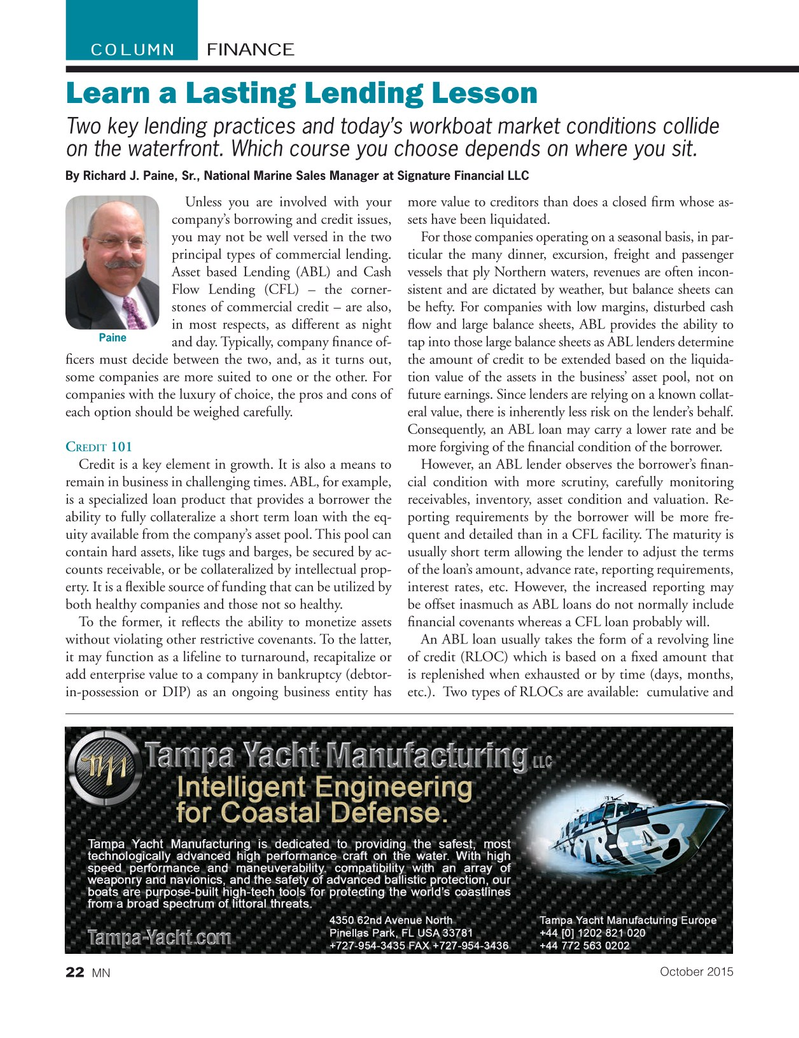
Page 22: of Marine News Magazine (October 2015)
Salvage & Spill Response
Read this page in Pdf, Flash or Html5 edition of October 2015 Marine News Magazine
COLUMN FINANCE
Learn a Lasting Lending Lesson
Two key lending practices and today’s workboat market conditions collide on the waterfront. Which course you choose depends on where you sit.
By Richard J. Paine, Sr., National Marine Sales Manager at Signature Financial LLC
Unless you are involved with your more value to creditors than does a closed ? rm whose as- company’s borrowing and credit issues, sets have been liquidated.
you may not be well versed in the two For those companies operating on a seasonal basis, in par- principal types of commercial lending. ticular the many dinner, excursion, freight and passenger
Asset based Lending (ABL) and Cash vessels that ply Northern waters, revenues are often incon-
Flow Lending (CFL) – the corner- sistent and are dictated by weather, but balance sheets can stones of commercial credit – are also, be hefty. For companies with low margins, disturbed cash in most respects, as different as night ? ow and large balance sheets, ABL provides the ability to
Paine and day. Typically, company ? nance of- tap into those large balance sheets as ABL lenders determine ? cers must decide between the two, and, as it turns out, the amount of credit to be extended based on the liquida- some companies are more suited to one or the other. For tion value of the assets in the business’ asset pool, not on companies with the luxury of choice, the pros and cons of future earnings. Since lenders are relying on a known collat- each option should be weighed carefully. eral value, there is inherently less risk on the lender’s behalf.
Consequently, an ABL loan may carry a lower rate and be
REDIT
C 101 more forgiving of the ? nancial condition of the borrower.
Credit is a key element in growth. It is also a means to However, an ABL lender observes the borrower’s ? nan- remain in business in challenging times. ABL, for example, cial condition with more scrutiny, carefully monitoring is a specialized loan product that provides a borrower the receivables, inventory, asset condition and valuation. Re- ability to fully collateralize a short term loan with the eq- porting requirements by the borrower will be more fre- uity available from the company’s asset pool. This pool can quent and detailed than in a CFL facility. The maturity is contain hard assets, like tugs and barges, be secured by ac- usually short term allowing the lender to adjust the terms counts receivable, or be collateralized by intellectual prop- of the loan’s amount, advance rate, reporting requirements, erty. It is a ? exible source of funding that can be utilized by interest rates, etc. However, the increased reporting may both healthy companies and those not so healthy. be offset inasmuch as ABL loans do not normally include
To the former, it re? ects the ability to monetize assets ? nancial covenants whereas a CFL loan probably will.
without violating other restrictive covenants. To the latter, An ABL loan usually takes the form of a revolving line it may function as a lifeline to turnaround, recapitalize or of credit (RLOC) which is based on a ? xed amount that add enterprise value to a company in bankruptcy (debtor- is replenished when exhausted or by time (days, months, in-possession or DIP) as an ongoing business entity has etc.). Two types of RLOCs are available: cumulative and
October 2015 22
MN
MN Oct15 Layout 18-31.indd 22 9/21/2015 11:08:55 AM

 21
21

 23
23
